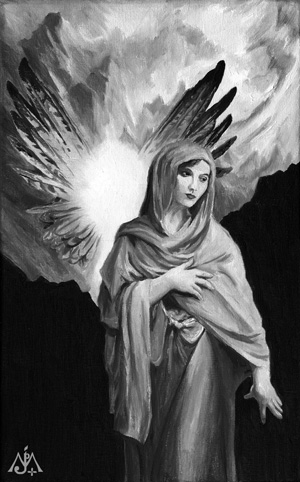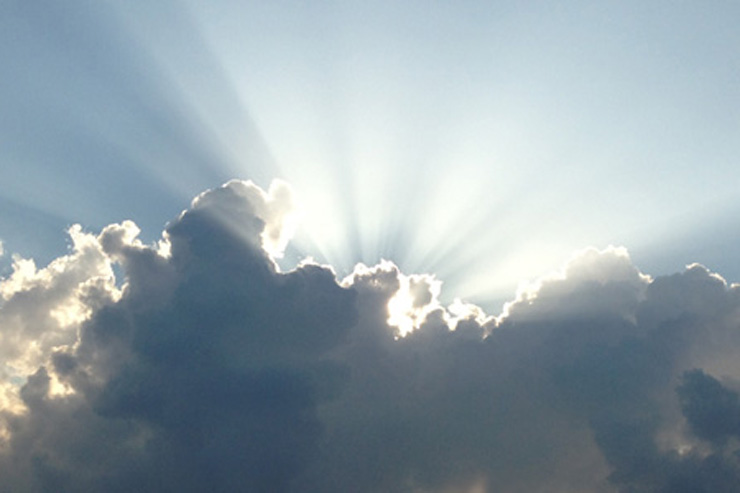
Artwork © by Jef Murray
I was once thoroughly stunned when a lady asked me, in all seriousness, whether Catholicism was a cult. This was the first of many times I have found myself attempting to debunk myths about my faith. Here are some rather prevalent ones with ammunition for setting the record straight:
- Catholics worship Mary. Here’s the truth: Catholics deeply respect Mary, but we worship only God. We ask her to pray for us, and we honor her because through her consent to God’s will, Jesus came into the world. In the Bible Mary said, “All generations will call me blessed.” Catholics fulfill her prophecy by venerating and loving her – and as St. Bernard reminds us, “We can never love her more than Jesus did.”
- Catholics worship statues. The fact is that Catholics have statues to remind us of the saints, but we certainly don’t worship statues or invest them with any spiritual powers. Statues call to mind the people we love, just as cherished family photos do. And there’s clearly a huge difference between glancing fondly at a photo of grandma – and worshiping it.
- Catholics aren’t Christians. This is a strange myth indeed, but sadly prevalent because many people wrongly believe the word “Christian” is synonymous with “Protestant.” To debunk this myth, it helps to remind people that Catholics were, in fact, the very first followers of Christ. Our founder was not Martin Luther, John Calvin, King Henry VIII, John Wesley, Mary Baker Eddy, or any of the other human beings who launched Protestant denominations. Instead, our founder was Jesus Christ who said to St. Peter: “Thou art Peter and upon this rock I will build my church.”
- Catholics never read the Bible. You might encourage people clinging to this myth to attend Mass, where they will hear multiple readings from the prophets, the psalms, the epistles and the Gospels. Huge portions of the Mass are based on Scripture, starting with the opening line from Jesus Christ: “Peace be with you.” Catholics also have wonderful prayer books such as “The Magnificat,” featuring Biblical readings and meditations on scripture.
- Catholics worship a piece of bread and a cup of wine. At Mass through the miracle of transubstantiation, the bread and wine becomes the Body, Blood, Soul and Divinity of Christ, although each retains its respective appearance as bread and the wine. Thus, Catholics don’t worship bread and wine, but Jesus Christ, who said “He who eats my flesh and drinks my blood has eternal life.” Unlike many other Christians, we take his words literally.
- Catholics think the Pope can’t make mistakes. In fact, Catholic teaching holds that the Pope can fall into error when it comes to everyday subjects such as literature, mathematics, physics and history. The Pope is fully human, which means he can also sin, and he needs a confessor. When Pope Benedict XVI talks about the Internet or writes a book such as “Jesus of Nazareth,” he certainly is not infallible. The doctrine of infallibility – meaning the inability to err – applies only when the pope makes binding, formal proclamations on faith and morals.
- Catholics don’t rely on the Bible for their beliefs. In truth, we rely on Sacred Scripture and Sacred Tradition for our beliefs. This makes sense because there was a church – and sacred tradition – before there was a formal Bible. In the late 4th century AD, the church proclaimed which writings should be included in the Bible. During the early centuries, Christians relied on oral tradition to hand down Christ’s teachings. The Bible itself gives credence to the importance of tradition when St. Paul says, “Stand firm and hold to the traditions which you were taught by us, either by word of mouth or by letter.” (2 Thessalonians 2:15)
There are many other myths about Catholics, and there are some good references to help you debunk them. One particularly good book is Why Do Catholics Genuflect? by Al Kresta. Another reliable source is The Catholicism Answer Book by Father John Trigilio and Father Kenneth D. Brighenti.
Lorraine’s latest books are “The Abbess of Andalusia,” a biography of Flannery O’Connor, and “Death of a Liturgist,” a mystery about a layman who wreaks havoc on a traditional parish. Jef Murray’s artwork for this column may be viewed in color at www.jefmurray.com
Please help us in our mission to assist readers to integrate their Catholic faith, family and work. Tell your family and friends about this article using both the Recommend and Share buttons below and via email. We value your comments and encourage you to leave your thoughts below. Thank you! – The Editors











